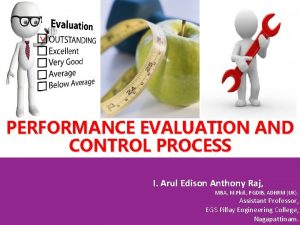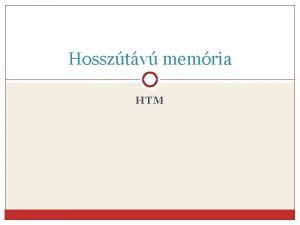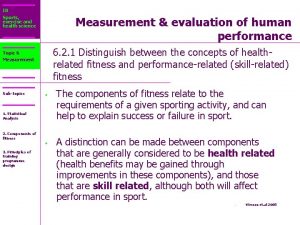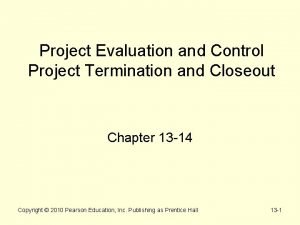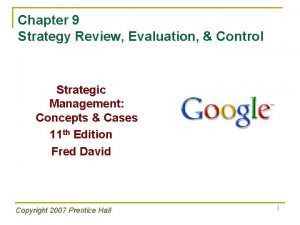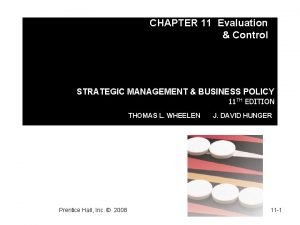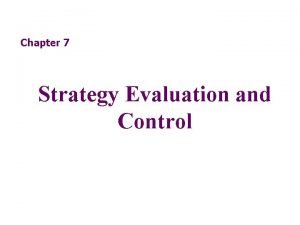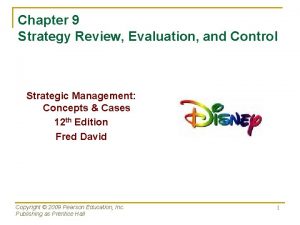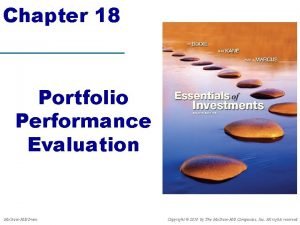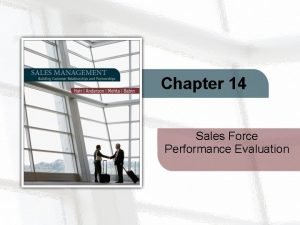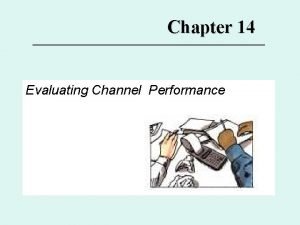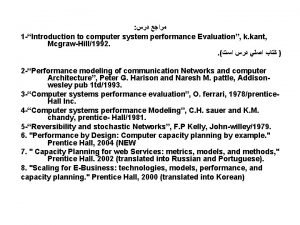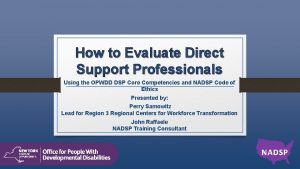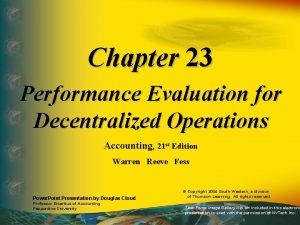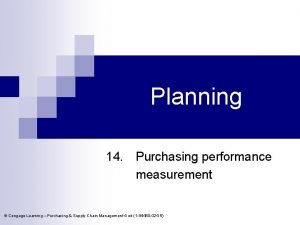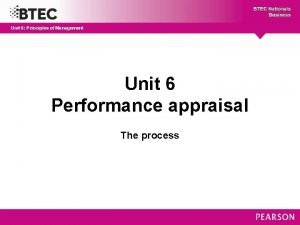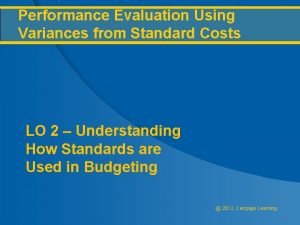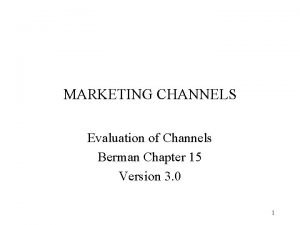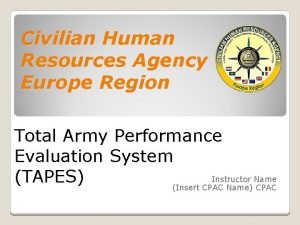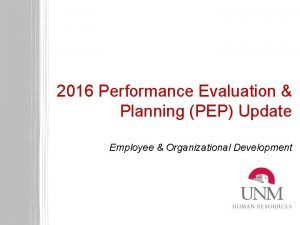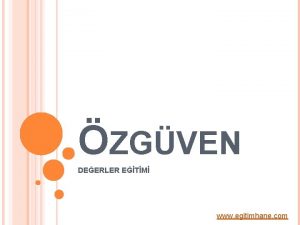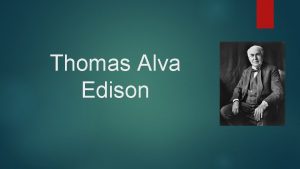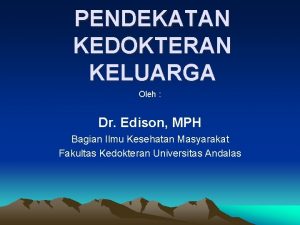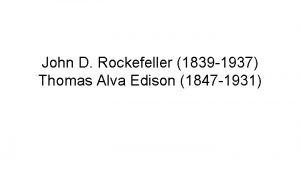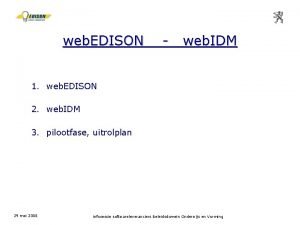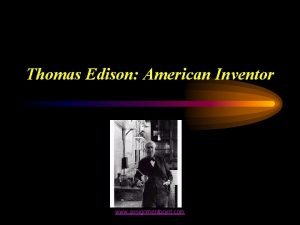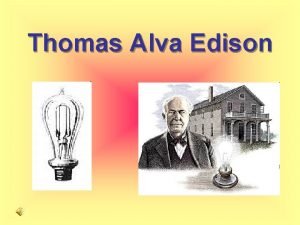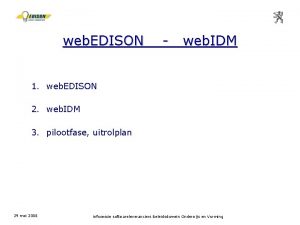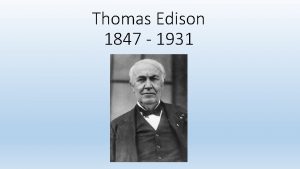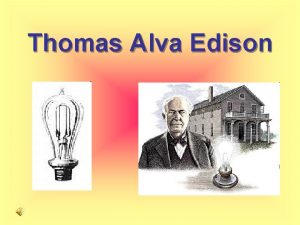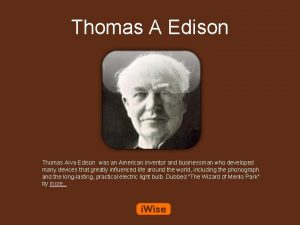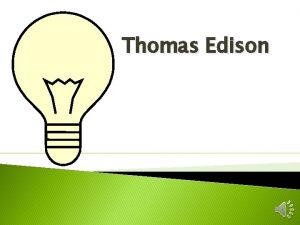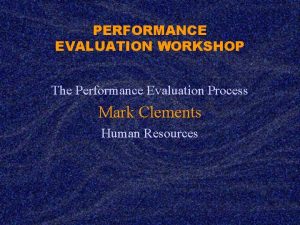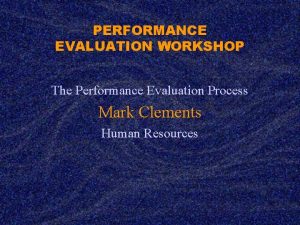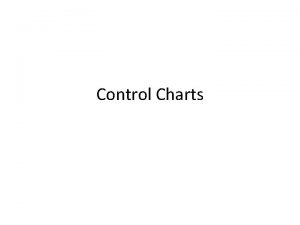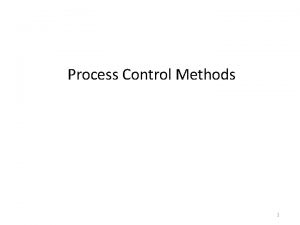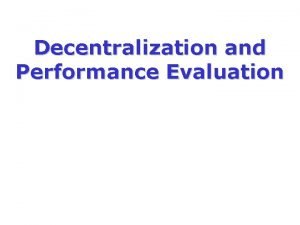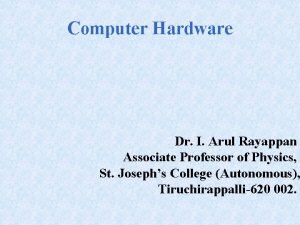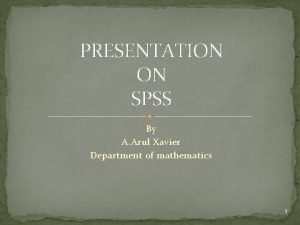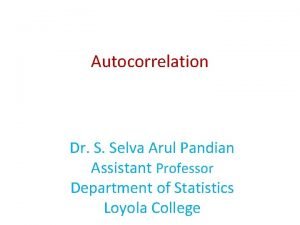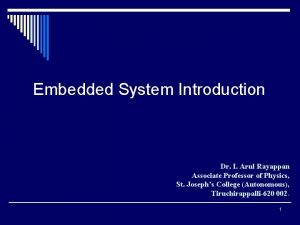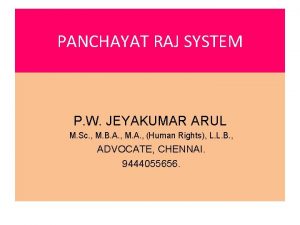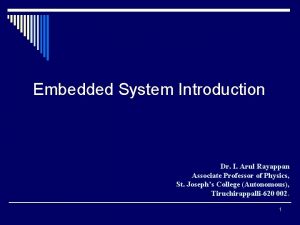PERFORMANCE EVALUATION AND CONTROL PROCESS I Arul Edison





















































- Slides: 53

PERFORMANCE EVALUATION AND CONTROL PROCESS I. Arul Edison Anthony Raj, MBA, M. Phil. , PGDIB, ADHRM (UK). Assistant Professor, EGS Pillay Engineering College, Nagapattinam.

PERFORMANCE APPRAISAL ▪ Performance appraisal is a method of evaluating the behaviour of employees in the work spot, normally including both the quantitative and qualitative aspects of job performance. ▪ Performance here refers to the degree of accomplishment of the tasks that make up an individual’s job. ▪ It indicates how well an individual is fulfilling the job demands.

Important Features of Performance Appraisal ▪ Performance appraisal is the systematic description of an employee’s job-relevant strength and weaknesses. ▪ The basic purpose is to find out how well the employee is performing the job and establish a plan of improvement. ▪ Appraisals are arranged periodically according to a definite plan. ▪ Performance appraisal is a continuous process in every large scale organization.

Need for Performance Appraisal ▪ Provide information about the performance ranks. Decision regarding salary fixation, confirmation, promotion, transfer and demotion are taken based on performance. ▪ Provide feedback information about the level of achievement and behaviour of the subordinate. This information helps to review the performance of the subordinate, rectifying performance deficiencies and to set new standard of work, if necessary. ▪ Provide information which helps to counsel the subordinate.

Purpose of Performance Appraisal ▪ To create and maintain a satisfactory level of performance. ▪ To help the superiors to have a proper understanding about their subordinates. ▪ To contribute to the employee growth and development through training, self and management development programmes. ▪ To facilitate fair and equitable compensation based on performance.

Content of Performance Appraisal (Content to be Appraised for an officer’s Job) ▪ Regularity of Attendance. ▪ Judgement skills. ▪ Ability to work with others. ▪ Integrity. ▪ Leadership styles & abilities. ▪ Capability for responsibility. ▪ Initiative. assuming ▪ Technical skill. ▪ Level of acceptance subordinates. ▪ Technical ability/knowledge. ▪ Honesty and sincerity. ▪ Creative skills. ▪ Knowledge of systems and procedures. ▪ Area of interest. ▪ Area of suitability. by ▪ Quality of suggestions offered for improvement.

Appraisers 360 o Performance Appraisal ▪ The appraiser may be any person who has through knowledge about the job content, contents to be appraised, standards of contents and who observes the employee while performing a job. ▪ The appraiser should prepare to capable of determining what is more important and what is relatively less important.

Appraisers ▪ He should prepare reports and make judgements without bias. ▪ Typical appraisers are: Supervisors Peers Subordinates Employees themselves Users of service and consultants ▪ Performance appraisal by all these parties is called “ 360 Performance Appraisal. ”

When to Appraise? ▪ Informal appraisals are conducted whenever the supervisor or personnel managers feel it necessary. However, systematic appraisals are conducted on a regular basis, say for example, every six months or annually.

METHODS OF PERFORMANCE APPRAISAL Methods of Performance Appraisal Traditional Methods Graphic Rating Scales Ranking Method Paired Comparison Method Forced Distribution Method Checklist Methods § Simple Checklist § Weighted Checklist § Critical Incident Method Essay or Free Form Appraisal Group Appraisal Confidential Reports Modern Methods Behaviourally Anchored Rating Scales Assessment Centre Human Resources Accounting Management by Objectives Behaviour Observation Scales Psychological Appraisal Results Method Productivity Measures Balance Scorecard

Managerial Appraisal ▪ Harold Koontz has developed a concept of managerial appraisal i. e. , appraising managers as managers. According to this concept, the managers attain organizational objectives by performing the basic managerial functions, viz. , ▪ Planning, ▪ Organizing, ▪ Leading, ▪ Motivating, ▪ Staffing, and, ▪ Controlling.

Uses of Performance Appraisal ▪ Organisational planning based on potentialities of its human resources. ▪ Human resources planning based on weakness, strengths and potentialities of human resources. ▪ Organizational effectiveness through performance improvement. ▪ Fixation and re-fixation of salary, allowances, incentives and benefits. ▪ Career planning and development and movement of employees.

Problems of Performance Appraisal ▪ The major problems in performance appraisal are: ▪ Rating Biases (it includes): ▪ Halo Effect ▪ The error of central tendency ▪ The leniency and strictness biases ▪ Personal prejudice and ▪ The recency effect ▪ Most part of the appraisal is based on subjectivity. ▪ Some superiors completed appraisal reports within a few minutes. ▪ The situation was unpleasant in the feedback interview. ▪ Negative ratings affect interpersonal relations and industrial relations system.

Recent Developments ▪ Change in the Approach to Performance Management. ▪ Emphasis on Documentation. ▪ Computer – based Performance Management. ▪ Collaborative Performance Management. ▪ Customized Performance Management System.

Appraisal Interview ▪ The Appraisal (Feedback) Interview is a discussion between the supervisor and the employee concerning the employee’s past performance and how that performance can be improved in the future.

Purposes of the Interview ▪ Encouraging present behaviour. ▪ Explaining what is expected of employees. ▪ Communicating results of salary or promotion decisions. ▪ Planning for future performance improvement. ▪ Improving supervisor – subordinate relationships.

Types of Appraisal Interview ▪ Tell and sell approach: The supervisor acts as judge and jury and needs to persuade the ratee to change his/her behaviour in a prescribed way. ▪ Tell and listen approach: During the first part of the interview the employee’s strong and weak areas of performance are addressed; during the second part the focus falls on the employee’s feelings about the appraisal. ▪ Problem – solving approach: The supervisor acts as helper and facilitator and discusses the problems, needs, innovations, dissatisfactions, etc.

PROMOTION, TRANSFER & DEMOTION ▪ As a part of career management, companies move the employees from one level to the another level and from one job to the another job within the company. This practices is called internal mobility. ▪ Internal mobility are of three types viz. , ▪ Promotion, ▪ Transfer, and, ▪ Demotion,

PROMOTIONS ▪ According to Paul Pigors and Charles A. Myers defines, “Promotion is advancement of an employee to a better job – better in terms of greater responsibility, more prestige or status, greater skill and especially increased rate of pay or salary. ”

Types of Promotion ▪ Vertical Promotion: (Employee is moved to the next higher level, in the organizational hierarchy with greater responsibility, authority, pay and status). ▪ Up-gradation: (Job is upgraded in the organizational hierarchy. Consequently, the employee gets more salary, higher authority and responsibility. For example, the job of medical officer in Railways which was in Group C is upgraded as Group B position). ▪ Dry Promotion: (The employee is moved to the next higher level in the organizational hierarchy with greater responsibility, authority and status without any increase in salary).

Purpose of Promotion ▪ To utilize the employee’s skill, knowledge at the appropriate level in the organizational hierarchy resulting in organizational effectiveness and employee satisfaction. ▪ To develop competent internal source of employees ready to take up jobs at higher levels in the changing environment. ▪ To promote a feeling of content with the existing conditions of the company and a sense of belongingness. ▪ To build loyalty and to boost morale. ▪ To reward committed and loyal employees.

Bases of Promotion ▪ Organizations adopt different bases of promotion depending upon their nature, size, management etc. ▪ Generally, they may combine two or more basis of promotion. ▪ The well-established basis of promotion are “Seniority & Merit”. ▪ The other basis of promotion, which is well practiced in all types of organizations under different shades is “Favouritism”. ▪ Organization should have the idea of effectiveness of each basis in promoting the right man to the job.

Benefits of Promotion ▪ Promotion of employees from lower ranks to higher positions benefits the organization as well as employees: ▪ Promotion places the employees in a position where an employee’s skills & knowledge can be better utilized. ▪ It creates among employees a feeling of content with the existing conditions of work and employment. ▪ Promotion improves employee morale and job satisfaction. ▪ Ultimately it improves organizational health.

Problems with Promotion ▪ Through promotion benefits the employee and the organization, it creates certain problems. They are (i) disappointment of the candidates, (ii) refusal of promotions etc.

Promotion Disappoints Some Employees ▪ Some employees who are not promoted will be disappointed when their colleagues with similar qualifications and experiences are promoted either due to favouritism or due to the lack of systematic promotion policy. ▪ Employees may develop negative attitude and reduce their contributions to the organization and prevent organizational and individual advancement.

Some Employees Refuse Promotion ▪ There is a general tendency that an employee accepts promotion. But there are several incidents where employees refuse promotions. ▪ These incidents include promotion together with transfer to an unwanted place, promotion to that level where the employee feels that he will quite incompetent to carry out the job, delegation of unwanted responsibilities and when trade union leaders feel that promotion causes damage to their position in the trade union.

TRANSFER ▪ Moving of an employee from one job to another. It may involve a promotion, demotion or no change in job status other than moving from one job to another. ▪ Transfer is defined as “a lateral shift causing movement of individuals from one position to another usually without involving any marked change in duties, responsibilities, skills needed or compensation. ”

Types of Transfers Production transfer Replacement transfer Rotation transfer Transfer caused due to changes in production. Transfer caused due to initiation or replacement of a long standing employee in the same job. Transfer initiated to increase the versatility of employees. Shift transfer Transfer of an employee from one shift to another. Remedial transfer Transfer initiated to correct the wrong placements. Penal transfer Transfer initiated as a punishment for indisciplinary action of employees.

Reasons of Transfer ▪ To meet the organizational requirements ▪ To satisfy the employees needs ▪ To utilize employee’s skill, knowledge etc. , where they are suitable or badly needed. ▪ To correct inter-personal conflicts ▪ To punish the employees who violate the disciplinary rules ▪ To minimize fraud, bribe etc. , which result due to permanent stay and contact of an employee with customers, dealers, suppliers etc.

Reasons of Transfer ▪ Transfers are basically of three categories, viz. , ▪ Employee – initiated transfer ▪ Company – initiated transfer ▪ Public – initiated transfer

Employee – Initiated Transfer ▪ These transfer are also know as personal transfer. These transfers are primarily in the interest of the employee and according to his convenience and desire. Further, these transfers can be classified into following types; ▪ Temporary Transfer: ▪ Due to ill health or involvement of employees in accidents. ▪ Due to family problems like taking care of old parents etc. , ▪ Permanent Transfer: ▪ Due to chronic ill health or permanent disablement caused by accident. ▪ With a view to correct his wrong placement. Employee may not be interested with the work, working conditions or environment of his present job and hence may require a transfer.

Company – Initiated Transfer ▪ Transfers are also at the initiative of the company. ▪ Temporary Transfer: ▪ Due to temporary absenteeism of employees, ▪ Due to fluctuations in quality of production and thereby in work load. ▪ Permanent Transfer: ▪ Change in the quality of production, lines of activity, technology, organizational structure as discussed earlier. ▪ To improve the employee’s job satisfaction. ▪ To minimize bribe or corruption.

Public – Initiative Transfers ▪ Public also initiate the transfers generally through the politicians / government for the following reasons: ▪ If an employee’s behaviour in the society is against the social norms or if he indulges in any social evils. ▪ If the functioning of an employee is against the public interest. ▪ The major drawback of public initiated transfers is the politicalization of the issue. This drawback is more severe in government departments and public sector units.

Benefits of Transfer ▪ Transfers benefit both the employees and the organization. ▪ Transfer reduce employees monotony, boredom etc. , and increase employees job satisfaction. ▪ Further, they improve employees skills, knowledge etc. ▪ They correct erroneous placement and inter – personal conflicts. ▪ Thus, they improve employees morale.

Problems of Transfer ▪ Adjustment problems to the employee to the new job, place, environment, superiors and colleagues. ▪ Transfers from one place to another cause much inconvenience and cost to the employee and his family members relating to housing, education or children, etc. ▪ Transfer from one place to another result in loss of man-days.

DEMOTIONS ▪ The remaining type of internal mobility is ‘demotion’. It is the opposite of promotion. Demotion is the reassignment of a lower level job to an employee with delegation of responsibilities and authority required to perform that lower level job and normally with lower level pay. ▪ Organizations use demotions less frequently as it affects the employee’s career prospects and morale.

Reasons for Demotions ▪ Unsuitability of the employee to higher level jobs ▪ Adverse business conditions ▪ New technology and new methods of operation demand new and higher level skills. If the existing employees do not develop themselves to meet these new requirements, organizations demote them to the lower level jobs where they are suitable. ▪ Employees are demoted on disciplinary grounds.

CONTROL PROCESS ▪ Controlling is the process by which management assures that actual activities conform to planned activities. ▪ Controlling is the managerial process for measuring progress toward planned performance and, when required, taking corrective actions.

Importance of Control ▪ Adapting to changing conditions ▪ Minimizing mistakes and errors ▪ Coping with organizational complexity ▪ Minimizing costs

CONTROL PROCESS 1. Establish standards 2. Measure performance 3. Compare performance & standards 4. Evaluate performance & take action Maintain the status quo Correct the deviation Change the standards

Requirements of Effective Control System ▪ Timeliness ▪ Accuracy ▪ Objective and comprehensiveness ▪ Economically realistic ▪ Organizationally realistic ▪ Focused on strategic control points ▪ Coordinated with the organizational workflow ▪ Prescriptive and operational ▪ Accepted by organizational members ▪ Flexibility

GRIEVANCES Grievance Procedure: ▪ According to Michael J. Jucions define Grievance as, “Any discontent of dissatisfaction whether exposed or not whether valid or not arising out anything connected with the company which an employee thinks, believes or even feels to be unfair, unjust or inequitable”.

Causes of Grievances The causes of employee grievances include: ▪ Demands for individual wage adjustments; ▪ Complaints about the incentive system; ▪ Complaints about the job classifications; ▪ Complaints against a particular foreman; ▪ Promotion; ▪ Violation of contracts relating to collective bargaining; ▪ Improper job assignment; ▪ Transfer from another department or another shift.

Steps in Grievance Procedure Stage 4 Complaint to Union No Yes Stage 3 Complaint to Divisional Head No Yes Stage 2 Complaint to Department Head Grievance Resolved No Yes Stage 1 Complaint to Section Head Grievance Resolved

Employee Discipline ▪ There are employees whose behaviour is in appropriately distruptive or performance is unacceptable. These problematic employees may be regularly ▪ ▪ ▪ ▪ Late for work, Have excessive absences, Fight with their co-workers, Consume drugs on the job, Refuse to obey their boss’s order, Violate safety rules, Or engage in other similar digressions. ▪ Under these circumstance, management must take disciplinary action against them.

Types / Forms of Discipline ▪ Preventive Discipline (or) Positive Discipline: ▪ Preventive Discipline is action taken to encourage employees to follow standards and rules so that infractions are prevented. ▪ Corrective Discipline (or) Negative Discipline: ▪ Corrective Discipline is an action that follows a rule infraction and seeks to discourage further infractions so that future acts are in compliance with standards.

Types of Discipline Problems 1. Attendance ▪ Unexcused absence ▪ Leaving without permission 2. On-the Job behaviours ▪ Failure to obey safety rules ▪ Sleeping on the job ▪ Fighting 3. Dishonest ▪ Clock-punching another’s timecard ▪ Concealing defective work 4. Outside Activities ▪ Outside Criminal Activity ▪ Wage garnishment ▪ Working for a competing company

Approaches to Discipline ▪ The three famous approaches to discipline are: ▪ Hot-Stove Rule, ▪ Progressive Discipline and ▪ Counselling Approach

Hot-Stove Rule ▪ A useful guide for corrective discipline is the hot-stove rule. ▪ The hot-stove rule state that disciplinary action should have the same characteristics as the penalty a person received from touching a hot stove ▪ The four characteristics/consequences that discipline should be with warning, immediate, consistent, and impersonal.

Progressive Discipline ▪ The progressive discipline is an approach in which a sequence of penalties is administrated, each one slightly more severe than the previous one. ▪ Progressive discipline also gives management time to work with an employee to help correct infractions.

Progressive Discipline ▪ Progressive discipline procedure: First offense Second offense Verbal Caution Written Reprimand Third offense Suspension Fourth offense Demotion Dismissal Typical Progressive Discipline System

Counselling Approach ▪ The counselling approach is fact-finding and guiding, instead of retaliatory. In this manner the employee’s self 0 image and dignity are retained and the supervisor-employee relationship remains cooperative and constructive.

Best of Luck for your Exam!!!!
 The purpose of
The purpose of Prof arul.philip
Prof arul.philip Recencia hatás
Recencia hatás Process control and product control
Process control and product control Progress and performance measurement and evaluation
Progress and performance measurement and evaluation Evaluation in progress
Evaluation in progress Measurement and evaluation in human performance 5e download
Measurement and evaluation in human performance 5e download Measurement and evaluation in human performance
Measurement and evaluation in human performance When thomas edison was born and died
When thomas edison was born and died Thomas alva edison was an american inventor and businessman
Thomas alva edison was an american inventor and businessman Putting it all to bed during project closeout includes
Putting it all to bed during project closeout includes Human factors in project evaluation and control
Human factors in project evaluation and control Strategy review evaluation and control
Strategy review evaluation and control Evaluation of business policy
Evaluation of business policy Techniques of strategic evaluation and control
Techniques of strategic evaluation and control Fatality assessment and control evaluation
Fatality assessment and control evaluation Strategy review evaluation and control
Strategy review evaluation and control Computer architecture performance evaluation methods
Computer architecture performance evaluation methods Portfolio performance evaluation problems
Portfolio performance evaluation problems Behaviorally anchored rating scale
Behaviorally anchored rating scale Three phases in the channel member performance audit
Three phases in the channel member performance audit Computer systems performance analysis
Computer systems performance analysis Usmc master brief sheet
Usmc master brief sheet Direct support professional performance evaluation
Direct support professional performance evaluation Performance evaluation for decentralized operations
Performance evaluation for decentralized operations Evaluating purchasing performance
Evaluating purchasing performance Citibank performance evaluation case study
Citibank performance evaluation case study Housekeeping performance improvement plan
Housekeeping performance improvement plan Evaluation for unit 6
Evaluation for unit 6 Stronge leader effectiveness performance evaluation model
Stronge leader effectiveness performance evaluation model Performance evaluation using variances from standard costs
Performance evaluation using variances from standard costs Library staff performance evaluation
Library staff performance evaluation Channel performance evaluation
Channel performance evaluation Performance evaluation model
Performance evaluation model Chra europe region
Chra europe region Unm pep
Unm pep Www egitimhane com
Www egitimhane com Samuel alva ixtlixóchitl
Samuel alva ixtlixóchitl Nubia marquez
Nubia marquez Edison decoder
Edison decoder Literally pronunciation
Literally pronunciation Sm educamos tomas alva edison
Sm educamos tomas alva edison Edison effect
Edison effect Edison framework
Edison framework Tomas edison quotes
Tomas edison quotes Dr edison
Dr edison Thomas edison philanthropy
Thomas edison philanthropy Investigating skills. thomas edison
Investigating skills. thomas edison Kuduz aşısını edison bulmuştur
Kuduz aşısını edison bulmuştur Thomas edison hayatı slayt
Thomas edison hayatı slayt Zoopraxiscope pronunciation
Zoopraxiscope pronunciation Topics in sports nutrition
Topics in sports nutrition Webidm
Webidm Edison never go to school
Edison never go to school
